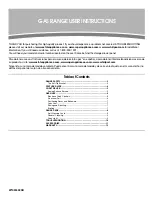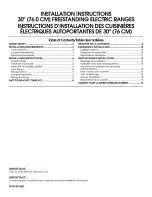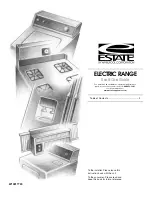
30
CONVECTION
Time
can
be
saved
by
baking
an
entire
batch
of
cookies
at
the
same
time.
The
cookies
will
bake
evenly
and
be
done
all
at
once.
The
baking
time
may
be
shorter
due
to
the
warm
circulating
air.
For
small
items
such
as
cookies,
check
to
see
if
they
are
done
one
to
two
minutes
before
the
recipe
time.
For
larger
baked
items
such
as
cakes,
check
five
to
six
minutes
before
the
time
indicated
on
the
recipe
.
Convection
cooking
of
meat
and
poultry
will
result
in
foods
that
are
brown
and
crispy
on
the
outside
and
moist
and
juicy
on
the
inside.
Large
meat
or
poultry
items
may
cook
up
to
30
minutes
less
than
the
suggested
time
so
check
them
so
they
will
not
be
over
baked.
A
meat
thermometer
or
an
instant
read
thermometer
will
provide
more
accurate
results
than
the
"minute
per
pound"
method.
The
larger
the
piece
of
meat
or
poultry,
the
more
time
you
will
save.
Converting Conventional Baking to Convection
Cooking -
To
convert
most
recipes
for
baked
items
(cookies,
cakes,
pies,
etc.),
reduce
the
oven
temperature
by
25°F.
For
meats
and
poultry,
use
the
temperature
recommended
in
recipes
and
cooking
charts.
CONVECTION
The
rear
element
operates
at
full
power.
Air
is
circulated
by
the
fan
for
even
heating.
Use
this
setting
for
food
which
requires
gentle
cooking
such
as
pastries,
soufflés
or
cakes.
TIPS
FOR
CONVECTION
and
BAKE
Preheating
the
Oven
Preheat
the
oven
before
baking.
The
oven
does
not
need
to
be
preheated
for
large
pieces
of
meat
or
poultry.
See
your
recipe
for
preheating
recommendation.
Preheating
time
depends
on
the
temperature
setting
and
the
number
of
racks
in
the
oven.
Temperature
Setting
When
using
Convection,
reduce
the
temperature
recommended
in
the
recipe
by
25°F.
When
roasting
meats,
check
internal
temperature
prior
to
time
recommended
by
recipe
to
prevent
over
cooking.
When
roasting
meats
in
convection
mode,
do
not
reduce
temperature
setting.
Condensation
It
is
normal
for
a
certain
amount
of
moisture
to
evaporate
from
the
food
during
any
cooking
process
The
amount
depends
on
the
moisture
content
of
the
food.
The
moisture
will
condense
on
any
surface
cooler
than.
the
inside
of
the
oven,
such
as
the
control
panel.
RACK
POSITIONS
Large
Main
Oven
One
Rack
Baking
When
baking
on
one
rack,
best
results
are
obtained
in
the
bake
mode
(see
Bake).
When
roasting
a
turkey
or
a
large
piece
of
meat,
convection
bake
may
be
used.
Rack
4
is
the
most
appropriate
rack.
Two
Rack
Baking
Racks
4
and
2
are
most
appropriate
when
using
the
convection
bake
mode.
Round
cake
pans
should
be
staggered
on
racks
4
and
2.
Rectangular
(9
x
13)
cake
pans
and
cookie
sheets
should
be
placed
on
rack
4
directly
under
the
one
on
rack
2.
This
may
be
used
for
cakes,
cookies,
biscuits
and
other
foods
for
which
two
rack
baking
is
desirable.
When
several
casseroles,
frozen
pies
or
cakes
are
to
be
baked,
use
racks
4
and
2.
These
two
racks
can
also
be
used
for
a
large
oven
meal.
Bake
ware
Type
Aluminium
bake
ware
gives
the
best
browning
results.
Cookie
sheets
with
only
two
sides
give
the
best
results.
Aluminium
commercial
half
‐
sheets
or
professional
cooking
utensils
may
be
used
but
baking
times
may
be
increased.
Placement
For
better
browning,
utensils
such
as
cookie
sheets.
Rectangular
baking
pans
should
be
placed
crosswise
on
the
rack
with
the
shorter
side
facing
right
and
left
to
allow
better
air
flow.
When
baking
on
more
than
one
rack,
cookie
sheets
and
rectangular
(9
x
13)
cake
pans
should
not
be
staggered;
round
cake
pans
should
be
staggered.
Settings
for
BAKE/CONVECTION
cooking
modes
These
cooking
modes
are
for
baking,
roasting
or
warming
using
one
or
two
racks.
1.
Select
BAKE/CONVECTION
using
the
Selector
switch.
2.
Set
the
oven
temperature
using
the
oven
temperature
control
knob
(not
over
Tmax=500°F
setting
position).
If
using
CONVECTION,
set
the
oven
control
knob
25°F
below
temperature
suggested
in
the
recipe.
Do
no
change
recipe
temperature
if
roasting
meats
or
poultry.







































